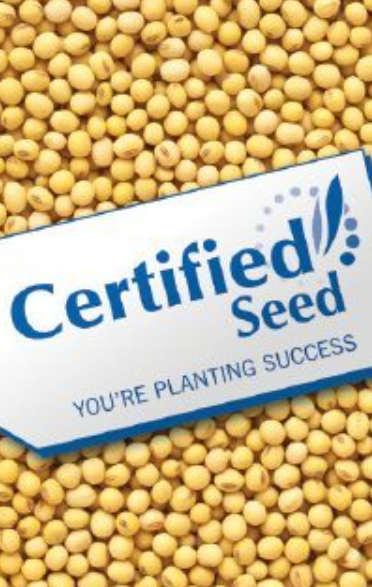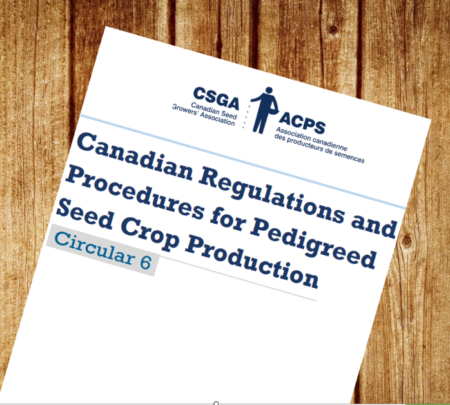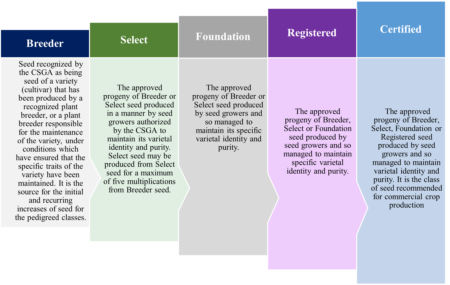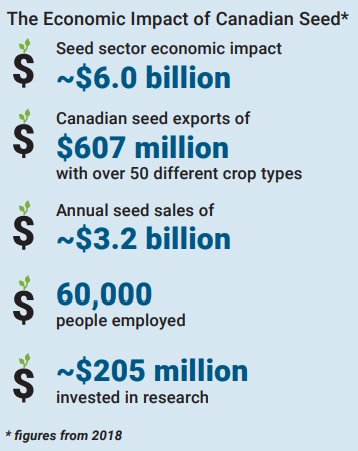Seed as a Starting Point
Using the best ingredients or inputs is common with virtually all things we do. When we prepare to cook or bake a meal, we ensure that the ingredients we use are as fresh and new as possible. The concept is similar for farmers when planting their crops each spring, they seek to use newly developed crop varieties, which contributes to ensuring that their yields will be as high as possible, as seed quality is an important part of ensuring a maximum yield. Each year that seed from the previous year’s crop is used to plan the next crop, there will be a small and gradual decline in seed vigour. This will occur over many years and at a more rapid pace in warmer climates. This results in lower germination rates of the seeds that are planted and the potential for lower yields from the seeds that do germinate as the expression of the traits will decline over time. As an example, seeds that have been developed to have improved disease resistance will have slightly lower levels of resistance from one generation to the next. The result is that over time, say a decade, the yield from a crop variety will be substantially lower than that of a brand-new variety. Because of the continual reduction in the quality of seed, it’s important to continually develop new varieties of crops.
Seed Certification ties to Seed Innovation

Research and development (R&D) in plant breeding is a key driver of agricultural innovation to produce new plant varieties and increase food production. The new varieties can include a single improvement, or multiple improvements, such as higher yields, improved nutrition, and better climate-resiliency. Over the years, increasing breeding efforts in Canada have led to better adapted varieties and more diverse production of various crops such as cereals to meet the challenges of the marketplace and the production concerns of producers. Developers of new varieties can protect their innovation from exploitation by others using Plant Breeders’ Rights (PBR), a form of intellectual property rights (IPR).
Owing to its seed certification system, Canada is a world-renowned leading producer and supplier of high-quality certified seed for a wide range of crops including cereals, oilseeds, pulses, forages, and special crops. Seed certification is a process of quality assurance, seed multiplication and commercial production that aims to ensure seed genetic identity and genetic purity. Since the 1960s, thousands of seed crops have been registered in Canada by the Canadian Food Inspection Agency’s (CFIA) Variety Registration Office. Variety registration systems ensure that the health and safety requirements of Canadians are met by new varieties.
Canadian variety regulations
 The CFIA is the federal agency responsible for the Seeds Act—which sets out the broad parameters of Canada’s seed regulatory framework, and Seeds Regulations. The Seeds Act governs both variety registration and pedigreed seed certification processes.
The CFIA is the federal agency responsible for the Seeds Act—which sets out the broad parameters of Canada’s seed regulatory framework, and Seeds Regulations. The Seeds Act governs both variety registration and pedigreed seed certification processes.
Variety registration focuses on verifying the characteristics and assessing the agricultural value of a new variety of a certain crop. While the Canadian Seed Growers’ Association (CSGA) is the national body responsible for prescribing varietal purity standards and certifying all crops (except potatoes), and pedigreed seed certification. Certification includes four classes from breeder seed: select, foundation, registered and certified, defined in Figure 1. The multiplication of these classes is subject to stringent production requirements by the CSGA, guaranteeing that off-types, weeds and other crop kinds are kept to a minimum to ensure the genetic purity of the seed.
Figure 1. Classes of pedigreed seed and their definition

Source: Designed based on the Glossary Terms from Circular 6.
Canada as an agricultural and agri-food superpower

Canada’s seed industry is made up of over 150 seed companies and 3,500 pedigreed seed producers. The seed sector contributes over C$6 billion in economic activity, employs more than 60,000 Canadians (seed farmers, plant breeders, intellectual property lawyers, etc.) and exports more than C$600 million. The industry represents over C$3.2 billion in annual sales in Canada. In 2020, Saskatchewan’s pedigreed seed industry was worth an estimated C$790 million to the province’s economy (https://saskseed.ca).
Commercialization of new varieties with desired attributes is essential to enable continued competitiveness of the agri-food sector in both domestic and export markets. Maintaining the domestic capacity to supply high-quality crops protects Canadian consumers from price shocks when purchasing food products.
With the growing world population, the threat of climate change, and the shrinking of grain reserves, how can the production of staple crops such as cereals keep up with the demand? In the next few decades, farmers will have to double their food production using limited resources such as water and land. Canada can lead the way to address these challenges and help feed a hungry world. Indeed, to offset lower wheat production from the European Union highlighted by the Ukrainian invasion, wheat exports from Canada and US are expected to increase between 2022-2023 according to the OECD-FAO Agricultural Outlook 2022-2031. As an international destination of choice for R&D, Canada should further invest in seed innovation and breeding programs to deliver new plant varieties with increased yield per acre and better quality. Intellectual property protection can foster more investments (private investments) in varietal development especially for cereals, currently dominated by the public sector.
High crop yields in Canada contribute to ensuring that domestic demands are readily met, which is an important factor in keeping food price increases as minimal as possible. The Western Canadian drought in 2021 resulted in lower yields, creating higher domestic crop prices, which contributed to higher food prices throughout 2022. The other significant benefit of high Canadian crop yields is that Canada contributes to improving food security in other countries from the high levels of crop exports.



Seed Innovation was a topic that really needed to be addressed, thanks for that.